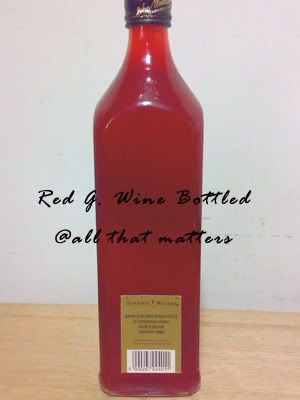
Red glutinous rice wine, or known as 红糟酒 , has its origin from China, 福州 , Fu Zhou (alternatively pronounced as Foo Chow or Hock Chew). From my understanding, it is mainly used in confinement meals (after delivering baby). Maybe it is used in other occasions too but since I do not have any friends from the dialect group, I am unable to verify. However, to me and my mom at least, you do not need any special occasions to enjoy good food! I have been wanting to make this wine for some time but I was not confident enough to do it. After successfully making my own fruit wine, I decided to embark on this experiment. Another factor that spurred me on is; my friend M is having a baby and is due this month.
After delivery of baby, the Chinese believes that the mother needs to recuperate and get back her health by eating norishing food and resting well. The confinement period can range from 30 days, 40 days or 3 months, depending on your lifestyle. From my personal experience, I was not allowed to eat certain food like yam, tapioca, sweet potatoes, mutton, prawns, etc., for 3 months. Cold drinks are not allowed. For 30 days, I was made to sit down when drinking fluid, I was not allowed to squat or bend down to carry heavy objects. I was also encouraged to lie down instead of sitting up for long period of time. The 'no-bathing' rule was ignored by me as I couldn't imagine myself stinking in my own sweat for 30 days. For food, it is believed that due to blood loss during childbirth, the body is 'cold' and thus need 'warm' elements like ginger and wine to 'warm' the body. So that's why alot of ginger is being used for confinement food. However, it should be warned that excessive ginger in the diet may also result in breastmilk jaundice (source : from a paedtrician). Taking large amount of wine is not advisable especially when you are breastfeeding.
Back to M, she has lent me her support and advice during a very difficult time. It is my little way of showing her my gratitude. I hope both she and her baby will be in good health. Can't wait to see her baby. I would like to share the method of making this wine with you. There were alot of myths about wine making but I have learnt from this site and Gina that they are unfounded. I would like to thank Gina for her guidance along the way. During wine making, the utmost important thing is hygiene. Just make sure everything you use is sterilised and clean. I have heard people citing bathing before making or you cannot make wine when it is 'That' time of the month (for the ladies). You must do it before sunrise or when there is no sun. You must do it alone. You cannot talk when making it. I rationalised them as hygiene and debunked some of the myths.
1) You have to wash your hands thoroughly, I washed mine up to the elbows as I have to reach inside the container during preparation.
2) I made this in the morning around 11 a.m. and the weather was rather warm.
3) Without having people around, you have no one to talk to. Unless you like to talk to yourself.
4) I did talk to my helper and Ah Girl.
The recipe is not mine can be found on the link above. Below are my personal notes and I have added sugar to the recipe. From what I learnt from fruit wine making, I applied here. Sugar is food for the yeast, it makes the yeast work harder. Thus for this batch, I am very happy that it yielded 1.4 litres of wine and 450g of wine lees (not entirely dry). Basically, the wine will be ready in 21 days. You can also harvest it after 30 days. I harvested the wine on the 24th day.
Red Glutinous Rice Wine (红糟酒)
Ingredients
1 kg Glutinous Rice (糯米) – weighed before cooking
120g Red Yeast (红糟) – blend into fine powder
1 pc Wine Yeast (酒饼)– mash into fine powder
1 Tbsp Sugar (糖)– optional
Method
1) Sterilise the glass bottle (I used 2 kg container) with hot water, overturn and leave to air dry for 2 days.
2) Cook glutinous rice in rice cooker with abit more water than usual. Leave to cool down completely. You can spread out on a tray to cool down faster but you need to cover it. I cooled the rice down in the rice pot overnight in my oven, covered it with an aluminum foil, leaving a gap.
3) Wash hand thoroughly up to your elbows. Make sure they are dry. Wear plastic gloves and mix cooked rice, red yeast, sugar and wine yeast together.
4) Transfer the mixture into the glass container, press it down as much as possible.
5) When done, cover the container with a clean piece of cloth, then close the lid but not too tight. Keep in a cool, dry and dark place (I covered the bottle with newspaper and black garbage bag).
6) Open the lid slightly to release gas on alternate days. Check if there is any mould (white, yellow, green, blue or even pink). If there is mould, you have to throw away and start again (might cause poisoning). After 1 day, you will see water vapour on the side of the container, bottom will start to collect wine. As it progress, the wine will be more but will stop at a certain level.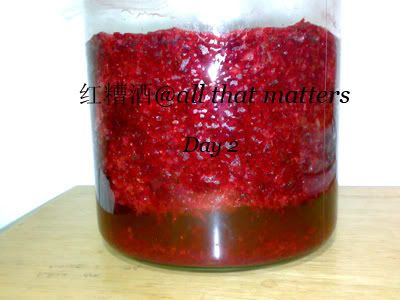
7) If there are no moulds, you can open it to give it a stir on the 7th day (remember to sterilize the ladle), or you can leave it for another 14 days or 23 days, until harvest to stir it. The mixture is quite liquidy. *Note : I forgot to stir on the 7th day, I stirred the mixture before harvest.*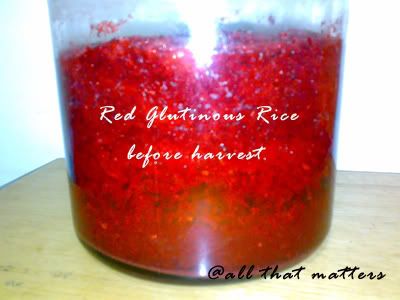
8) To harvest, use a piece of cheesecloth (baby cloth diaper – new of course) to collect the wine, tie the end with string, hang and let it drip. Collect the wine and let it settle for 1 day. The top will be clear, the bottom will have residue. Slowly pour the top portion into a clean glass bottle, or use a wine ladle and funnel to bottle it. Careful not to disturb the wine. The residue can be added to the wine residue collected on the cloth. *Note : Don't waste mah..*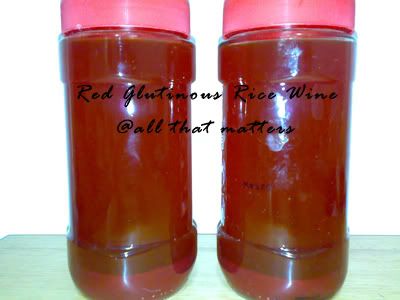
9) Collect the wine residue left in the cloth in a jar. Do not throw this away as you can use it to cook with chicken. This is the 红糟 or known as 酒糟 .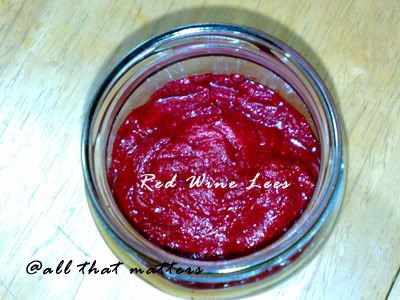
*Further notes : This is what Gina has shared with me. For commercial wine lees, they added salt for longer shelf life and to stop the fermentation. For homemade, you can leave the lees outside, it will still continue to ferment and excrete wine. For the wine, it will continue to age if you leave it outside, however, you have to keep in a cool place and for maximum of 3 months. Else it will become acidic and turn into vinegar. If it turns into vinegar, fret not and throw away not. You can make pickled ginger with it. However, if you are to add some wine lees into the wine, you can keep it out longer without spoilage. The wine will age and develop more flavour. Alternatively, just store the wine in the fridge to stop the fermentation.
I would like to highlight on the mould part. For me, once there is mould, it means something has gone bad, so I will throw away. Some arguments may say that there are good moulds present. While I do not deny that there are good moulds (like those on cheese) however, I am not a trained personnel to differentiate between good moulds and bad moulds. For safety sake, I would suggest throwing it out rather than risk food poisoning. In normal circumstance, if you did a good job on the hygiene part, mould shouldn't appear.
I hope you will find these information useful. And maybe try it out for your loved ones or beloved girl friends. I'm sure they will appreciate your effort.
それじゃ~~
PS : I'm starting another batch for my mom soon!
*Edit to add : My mom said that besides using the wine lees to stir-fry chicken, you can use it to stir-fry pork ribs or steam fish. There's another popular way of using it is cooking 红糟面线 (Mee Suah, also known as wheat flour vermicelli).
Super Easy, Super Moist Chocolate Cupcakes
4 years ago


















7 comments:
i just wrote a post on rice wine (not posted yet). i failed in my attempt bc i didn't know how to strain the wine frm the residue. this is great, thanks for such a detailed post!
Terri : Hi, I'm making another batch using a slightly different preparation method. Let's exchange notes. See it in another 30 days! :D
Hi Rei, congrats to your successful wine-making!
Though the hong chao is largely enjoyed during confinement, the foo chow also use them (both the wine & lees) in the daily cooking.
The wine is commonly added to the daily dishes to add flavour. Dishes include oyster sauce chicken & stir fried veg.
Lees are usually for making the mee sua which you already know) chicken soup, or stir fried pork rib. The possibilities unlimited! In my hometown you see people eating dishes cooked with wine and lees!
Cookie : Hi, thanks for the info! Appreciate it. So it is not confined to confinement food only. :D I hopped by your blog. I'm currently devising a new way to get the rice into the container. Hah! I'll leave a message there. See U!
Hi, you can use the residue to make bread too.
Hi,
Can I ask where did you get the container, red yeast and wine yeast?
I'm keen to try this but not sure where to get all the stuff?
Hi,
Can I ask where did you get the container, red yeast and wine yeast?
I'm keen to try the recope but not sure where to get the stuff.
Post a Comment